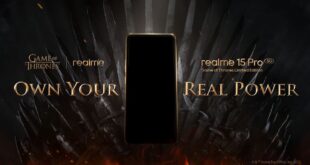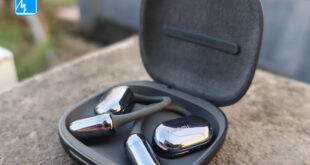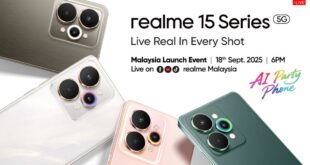The Xiaomi Redmi 14C targets the affordable segment of the smartphone market by offering quality specifications at low pricing.
I have been reviewing the phone for a week now, and this is my full review of the smartphone.
You can jump to any section of the review easily below if you do not want to read the whole lengthy article.
- Main highlights
- Design & body
- Screen & Display
- Audio system
- Processor, RAM & Storage
- Software
- Camera
- Durability
- Battery
- Conclusion
Main highlights
One of the main highlights of the Redmi 14C is the immersive 6.88-inch display which really shines when in use. The screen comes with a 120Hz refresh rate, and has a massive 5,160mAh battery which can be recharged with 18W fast charging.
The phone comes with a 50MP Ai dual camera and a 13MP super-clear selfie camera while it also boast an 8.22mm ultra slim body with up to 16GB of RAM supporting it’s powerful octa-core processor.
Design & body
Specs: 171.88mm x 77.8mm x 8.22mm, 207g, Side fingerprint sensor.
The phone in my opinion feels huge in my palms, and it is indeed slightly larger than other smartphones which fall within its price range.
Despite being slightly bigger, it is still nice to hold, and the flat edges allow for better stability when gaming.

The 8.22mm thin phone feels just right with the accompanying silicone case attached because while the case does add some bulk to the phone, it feels ‘normal’.
The Safe Green colour I received had a nice matte feeling to it, and it didn’t attract any fingerprints as well. Surprisingly, the glossy camera bump didn’t attract fingerprints as well, ensuring the phone keeps its elegence regardless of handling. Besides the Sage Green, the phone also comes in Starry Blue, Dreamy Purple, and Midnight Black.
If you want to know more about what I think about the Xiaomi Redmi 14C’s design, you can read my first impression of the phone in the link below.
Screen & Display
Specs: 6.88 inch Dot Drop Display with 89.7% screen-to-body ratio. 1640×720 resolution, 120Hz peak refresh rate, 600 nits maximum brightness
The Redmi 14C’s screen is a joy to use when watching videos. Colours appear vivid and clear, providing that cinematic experience when I tune to Netflix or any streaming service. The bigger size of the screen meant I had a bigger display to watch movies and videos as well.
The auto-adjusting refresh rate also makes gaming more enjoyable as responses are faster to play.

Under the sun or bright light, I do not need to adjust the screen brightness because the 600nits maximum brightness allows the phone to adjust to different lighting automatically.
In addition, the phone has two TÜV Rheinland certifications, namely TÜV Low Blue Light certification (Software Solution) and TÜV Flicker Free certification, which can protect my eye sight as well.
One thing I didn’t favour is how the lower chin of the phone seems to have a bigger bazel if compared to the rest, but I’m just nit-picking here and it isn’t a deal breaker for the phone.
Audio System
Specs: 3.5mm headphone jack
I personally like how the Redmi 14C audio presents itself despite being only having down-firing speakers.
The sound is sharp, crisp and accurate, and not mentioning loud.

However, as all single firing speakers, playing games on the phone would result in the speakers being muffled by my hands so the sound get’s ‘distracted’.
Lucky, the phone comes with a 3.5mm headphone jack which allows me to immerse myself in the smartphones audio without interruption.

Processor, RAM & Storage
Specs: 16 (6 +10)GB RAM, 128B storage space, MediaTek Helio G81-Ultra processor
The MediaTek Helio G81-Ultra procesor provides adequate performance when the phone is in use, and the 16GB of RAM (10GB is from it’s expansion RAM), gives the phone fluidity when I am opening and closing apps, as well as multitasking.
Of course, the performances of the phone can’t compare to higher end smartphone, but for typical use, it works.
I was a bit dissapointed that the phone did offer only 128GB of eMMC storage because using UFS storage would be better. Aside from that, the limited 128GB storage space meant there is little room for the use of the RAM expansion once the phone storage is full, which could in turn cause slowness in the phone’s usage.
This issue can be addressed by opting for the Redmi 14C variant which offers more RAM and storage space, but that of course comes with a slight price increase.
Software
Specs: Xiaomi HyperOS (Based on Android 14)
The Xiaomi HyperOS runs smoothly and does not dissapoint. It is also snappy and easy to use, and does multitasking without much fuss.
There is plenty of customisation and themes to choose from, and when I used the phone for gaming, it also activates a function called ‘Game Turbo’ which allows me to further boost performances by freeing up storage space, memory and more.
Camera
Specs: 13MP front camera, 50MP main rear camera
The Redmi 14C has a 50MP main rear camera which comes with modes like filmCamera, HDR mode, Night mode, Portraint mode and time-lapse. Xiaomi does call it an AI dual camera, but I could not find any AI functions to activate or use, except for the ‘beautify’ function which automatically improves the photo I’ve taken.

Personally, images taken using the rear camera are average in my opinion despite the 50MP tagline, both in videography and photography.
Photos and videos taken with the Redmi 14C also appear with a darker shade in my opinionwith the front camera 13MP shooter also coming out in similar shade.
Photography
To show you the phone’s capabilities, here’s a few photos I took with the phone in different scenarios.
The photos below are the ones I took in good lighting.



The phone misses out on any wide angle zoom and only comes with 1X and 2X zoom, with up to 10X digital zoom. The 1X zoom can be seen below.

Meanwhile a photo of the same building and place taken using the 2X zoom can be seen below.

The phone has the capabilities to do a 10X digital zoom, but like most digital zooms, the 10X zoom isn’t great and it was grainy.
Night photography has its own mode, and the photos below are what I captured with the rear camera.


Selfies (first photo below) and portrait (second photo below) shots do seem good and natural, with good bokeh effects as well.


Food photos are good when lighting is good, but seem to appear slightly dull if the environment is darker.


Videography
The absence of OIS or image stabilisation means that videos taken with the Xiaomi Redmi 14C do suffer from some shake when taken without any gimbal.
When used for vlogs, the video turns out average with shake noticeable. The video below shows my videography test of the smartphone in different situations.
Battery performance
Specs: 5,160mAh battery with 18W Fast Charge
The battery performance for this Redmi 14C is good as it can last for about 10 hours on a typical use of mine, which includes slight gaming, photography, social media and movie watching.
Once the battery is out, a quick charge with the 33W charging block would juice up the phone from zero to full in about 90 minutes.
I do find it interesting, and at some point confusing that the phone comes with a 33W charging adapter, but can only supports 18W fast charging.
Durability
Specs: No specs mentioned
The Redmi 14C was tested with 210,000 power button tests, 300 roller test, 5,000 headphone jack tests and 10,000 tests to ensure its durability.
It however does not have any IP rating so I would avoid getting the phone drenched.
Xiaomi Redmi 14C review verdict & availability
Overall, the Redmi 14C fits its pricing and status as an entry level smartphone, in which you get what you paid for. You can get it for RM499 which makes it very affordable.
Do get this phone if you are looking to enjoy movies and have a phone which last for quite sometime on a single charge.
However, if you are planning on taking photos particularly in dark environments, this phone may not be the best option for you.
 PhoneSentral Tech in Simplicity
PhoneSentral Tech in Simplicity



